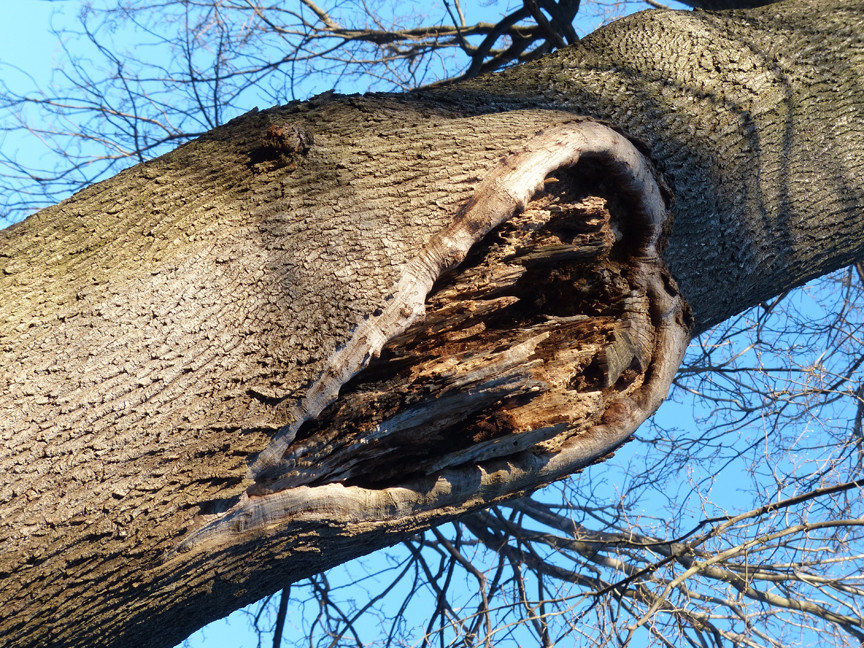Our oldest neighbors
There are many reasons for buying a home — relative privacy and quiet, a chance to garden and a yard for the kids to play in and to entertain guests. There are, of course some downsides — no super, no doorman, repairs and upkeep, shoveling snow and mowing the lawn. Yet despite these nuisances, I was thrilled to move from an apartment to a house so many years ago.
Walking around prospective properties, you check out the ambiance of the property, flower beds, the unbuilt space available for the children to play in. But you rarely think much about the oldest residents of the property, which are the trees. If you are lucky, there will be one or more tall specimens that give shade in the summer and balm to the soul simply by growing there. In our backyard we are lucky to have a 70-foot red oak that is estimated to be about 150 years old and, in the words of our arborist, “is almost perfectly shaped.”
We tend to think of trees as caring for themselves which, unfortunately, is a rather naive expectation. They require regular maintenance, particularly pruning to remove dead wood — clearly where the expression getting rid of the dead wood comes from — and additionally to fashion them into the most beautiful form possible for that species. The two recent major hurricanes — Irene and Sandy — toppled many of my trees, especially the locusts, and broke many branches in a de facto “natural” pruning. But Bob Whitney of Robert Whitney Tree Service, who did some work recently on our trees, is highly poetic in his description of his profession. He tells the story of Michelangelo, who would begin a sculpture by examining his block of stone from all sides carefully since he felt he was not, in fact, creating a particular statue but rather liberating the form that already existed from within the block. Bob Whitney sees the pruning of trees as creating a living sculpture.
Watching the young man who ascends the tree trunks to dizzying heights — known surprisingly as the climber — to remove dead branches or to begin the process of taking down a tree, is to renew your respect for many of those invisible workers who profoundly and positively impact our lives. According to Mr. Whitney, tree pruning requires a combination of strategic planning, spatial configuration and applied physics. While taking down an entire tree on the interior of a property can take some time since the branches first have to be removed and lowered by rope and then blocks of the trunk are sequentially removed and lowered, I saw a crew from the Parks Department using a bucket ladder take down and completely remove a 30-foot street tree in 50 minutes.
Rope techniques for tree work appear deceptively low-tech. Our present-day methods seem to have originated with English and Irish sailors who had to devise methods to manage the raising and lowering of the small and large sails of long-ago sailing ships. Many of those sailors settled in Manhattan and subsequently worked there and in Riverdale as arborists.
Walking through Riverdale, you can easily spot pruned street trees. Like healing scabs on a person’s arm there is the clear formation of healing wound tissue on the damaged wood. These distinctive formations are referred to as tree calluses and when cuts are made on small branches the calluses will eventually grown in a complete circle with a rolled edge around the cut portion. The freshly cut part of the branch which the callus will surround and eventually cover over is called the rot pocket. However, branches larger than about 4 inches in diameter when cut, pose a problem since the cut will rarely heal over the rot pocket entirely and will eventually cause trunk decay.
Wood decay conjures up only negative images. But since nature is in constant flux with new growth morphing into mature growth that, in turn, eventually decays, with the cycle continuing ad infinitum, we should not be surprised that decaying trees are beneficial to some creatures. Standing dead and dying trees are referred to by conservationists as “snags.” Many birds depend on the cavities in these trees, among them bluebirds, chimney swifts and purple martins. Mammals denning in hollow trees include squirrels, opossums (which I have actually seen), raccoons, bats and skunks (which I have unfortunately also seen).
Nothing goes to waste in the natural world. We just have to have the patience to see the new forms into which familiar plants are transmuted and discern the new purposes they serve.
Green scene is a new weekly column focusing on nature in the backyards and byways of Riverdale and beyond. Author Sura Jeselsohn is a longtime Riverdale resident.






